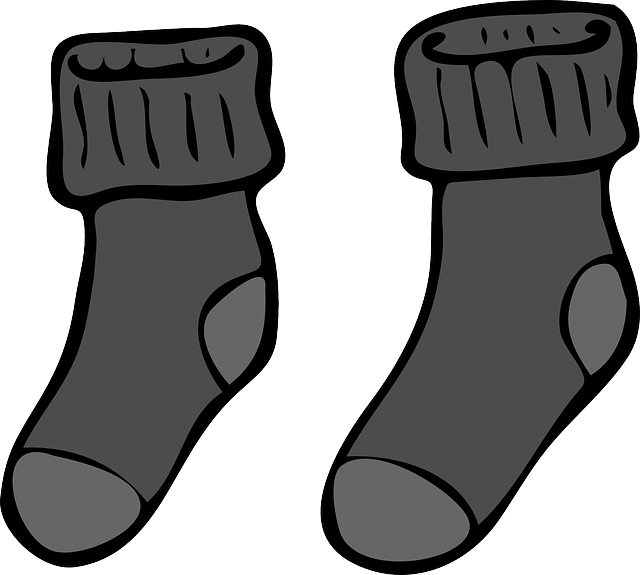
Whether you’re sprinting through your morning run, pushing through a high-intensity workout, or trekking up a steep trail, what you wear on your feet matters. While shoes often steal the spotlight, the unsung hero of comfort and performance is the sock—specifically, what it’s made of.
The best materials for sports socks can mean the difference between a great training session and one filled with blisters, overheating, or discomfort. Well-designed sports socks not only cushion your feet, but also manage sweat, reduce odor, and prevent injuries caused by friction or poor circulation.
In this comprehensive guide, we explore the top materials used in sports socks—ranging from natural fibers like Merino wool to advanced synthetics like CoolMax and polypropylene—to help you choose the best pair for your sport, weather, and foot needs.
1. Merino Wool: The All-Purpose Champion
When talking about the best materials for sports socks, Merino wool stands out as a gold standard. This natural fiber, sourced from Merino sheep, offers a unique blend of comfort, breathability, and temperature control that synthetic materials often struggle to match.
Why Merino Wool Works So Well
Merino wool isn’t like the coarse, scratchy wool you may be used to. It’s incredibly fine and soft, making it ideal for next-to-skin wear—especially in performance socks. Here’s why athletes and outdoor enthusiasts love it:
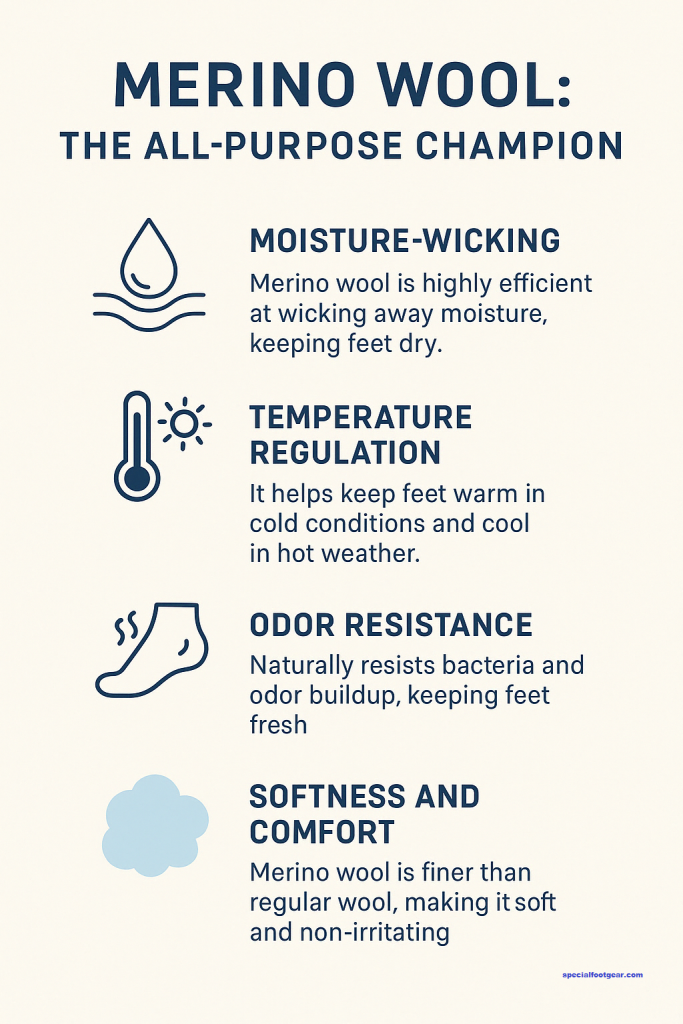
- Moisture-Wicking Power
Merino wool pulls sweat away from your skin and pushes it outward, keeping your feet dry. Dry feet mean fewer blisters and more comfort during long-distance activities. - Natural Temperature Regulation
One of Merino’s greatest strengths is its ability to keep you warm when it’s cold—and cool when it’s hot. It creates a micro-climate inside your shoe that balances temperature naturally. - Odor Resistance
Thanks to its antibacterial properties, Merino wool keeps odor-causing bacteria at bay. You can wear Merino wool socks for extended periods without worrying about foot odor. - Soft and Non-Irritating
Unlike traditional wool, Merino fibers are incredibly fine, which means they won’t itch or chafe—even during long hikes or back-to-back workout sessions.
Best Use Cases for Merino Wool Socks
Merino wool is ideal for sports that require endurance and adaptability in changing environments:
- Outdoor boot camps or military-style training
- Running (especially long-distance)
- Hiking and trekking
- Skiing and snowboarding
- Trail walking or mountain biking
2. Synthetic Fabrics: Durable and Efficient
If you’re seeking long-lasting sports socks that hold up to high-intensity training and frequent washing, synthetic materials are a top-tier choice. These fabrics—primarily polyester, nylon, and acrylic—are engineered for athletic use, making them an essential part of the conversation around the best materials for sports socks.
Why Synthetic Materials Excel in Sports Performance
Synthetics are popular in both budget and premium performance socks, and for good reason. Each fabric brings unique strengths to the table:
- Polyester
This lightweight, hydrophobic fabric is known for its quick-drying and moisture-wicking capabilities. It keeps your feet dry and blister-free, especially during long training sessions or humid conditions. - Nylon
Often blended with other materials, nylon adds flexibility and strength to socks. It’s abrasion-resistant, holds shape well, and increases the lifespan of your socks—even under heavy athletic use. - Acrylic
Commonly found in cushioned socks, acrylic mimics the softness of wool while offering the benefits of synthetic durability. It retains warmth without the weight and is often used for shock-absorbing support. - Polyamide
Less commonly discussed but extremely effective, polyamide contributes to breathability and elasticity, often appearing in high-end running or cycling socks.
Key Advantages of Synthetic Fabrics in Sports Socks
- Superior Moisture Management
Unlike cotton, synthetics wick moisture away from your skin rather than soaking it up. This reduces friction, lowers the risk of blisters, and keeps feet cool and dry. - Durability Over Time
Synthetic socks can endure multiple wash cycles, resist pilling, and maintain elasticity even after extended wear. That makes them perfect for people who train frequently. - Form-Fitting Comfort
These materials easily blend with spandex or elastane, allowing the socks to contour perfectly to your feet without sagging or bunching. - Quick Drying
Whether you’re washing socks between games or running through wet trails, synthetic fibers dry far faster than natural options like cotton or even wool.
Best Sports for Synthetic Socks
Synthetic socks are a go-to for a wide range of sports, especially high-intensity and sweat-heavy activities:
- Running and sprinting
- CrossFit and HIIT
- Tennis and racquet sports
- Road cycling and spin classes
- Gym workouts and circuit training
3. Cotton: Comfort But Not Ideal for Intense Sports
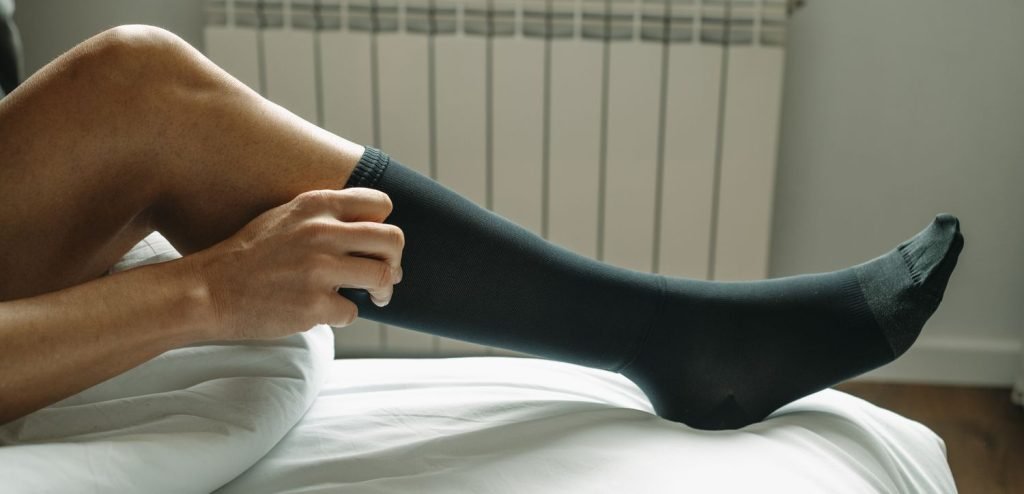
While cotton is one of the most common materials in everyday socks, it doesn’t hold the same reputation when it comes to high-performance athletic use. Despite its natural softness and breathability, cotton lacks several key features that athletes need—especially when it comes to moisture management and durability.
That said, cotton still has a place in the conversation about the best materials for sports socks, particularly for light, casual activity.
Advantages of Cotton Socks
- Soft and Skin-Friendly
Cotton socks are exceptionally soft and gentle, making them ideal for people with sensitive skin or for those who spend their day in lower-impact environments. - Breathable
Natural cotton fibers allow for air circulation, which can keep your feet cooler in dry, moderate climates. - Affordable and Widely Available
Cotton socks are budget-friendly and easy to find in stores, making them a go-to option for casual users or backup pairs.

Why Cotton Falls Short in Sports Performance
For active use, especially during workouts that involve sweat, movement, and friction, cotton has several downsides:
- Retains Moisture
Unlike Merino wool or polyester, cotton soaks up sweat and holds it. That moisture lingers against your skin, creating the perfect environment for blisters, hot spots, and even fungal infections. - Slow to Dry
Once wet, cotton takes much longer to dry compared to synthetic or performance-focused materials. This can lead to discomfort during extended training sessions. - Lacks Compression and Shape Retention
Cotton socks tend to stretch out quickly, especially after a few washes. They don’t provide the snug, supportive fit that performance socks require.
Best Uses for Cotton Sports Socks
Though cotton isn’t ideal for intense physical activity, it still has utility in low-sweat, low-impact environments:
- Yoga and Pilates
- Casual walking or daily errands
- Office or travel socks
- Lounging and home wear
Cotton socks are a great everyday comfort choice, but if your goal is to enhance athletic performance or avoid sweat-related issues, they’re best saved for rest days.
4. Polypropylene: The Moisture-Control Expert
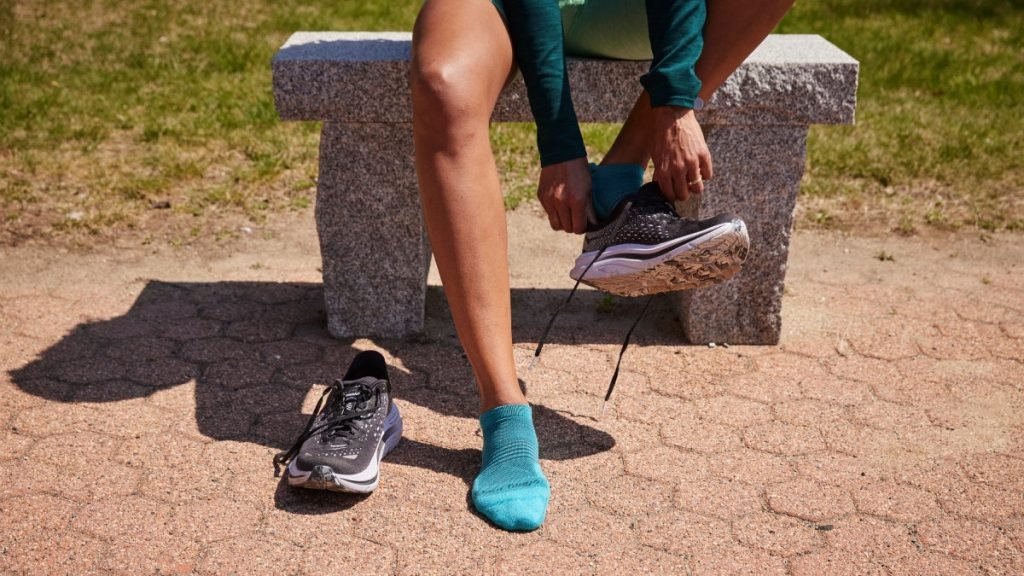
When it comes to specialized athletic performance, polypropylene is often an underrated but essential player in the world of sportswear. This synthetic fiber is particularly valuable for those training in wet or cold conditions, making it a serious contender among the best materials for sports socks.
What Makes Polypropylene Stand Out?
Polypropylene is unique in that it is hydrophobic—meaning it repels water rather than absorbing it. This quality allows the material to keep feet dry, even when you’re sweating heavily or facing wet environments.
Let’s break down the benefits:
- Unmatched Moisture Management
Polypropylene doesn’t hold water. It pushes moisture away from the skin and into the outer sock layers, where it can evaporate quickly. This helps prevent that soggy sock feeling that can lead to blisters and fungal infections. - Quick-Drying Performance
If you’ve ever had to deal with soggy socks during a run or hike, you’ll appreciate how fast polypropylene dries. It’s ideal for multi-day outdoor adventures, wet climates, or activities where you’re constantly on the move. - Lightweight and Low-Bulk
Polypropylene socks are thin and low-profile but still offer warmth and moisture protection—making them a smart choice for layering under thicker socks in extreme cold. - Insulating in Cold Conditions
Despite its thin nature, polypropylene is also used in cold-weather sports because it retains warmth while pulling sweat away from the skin.
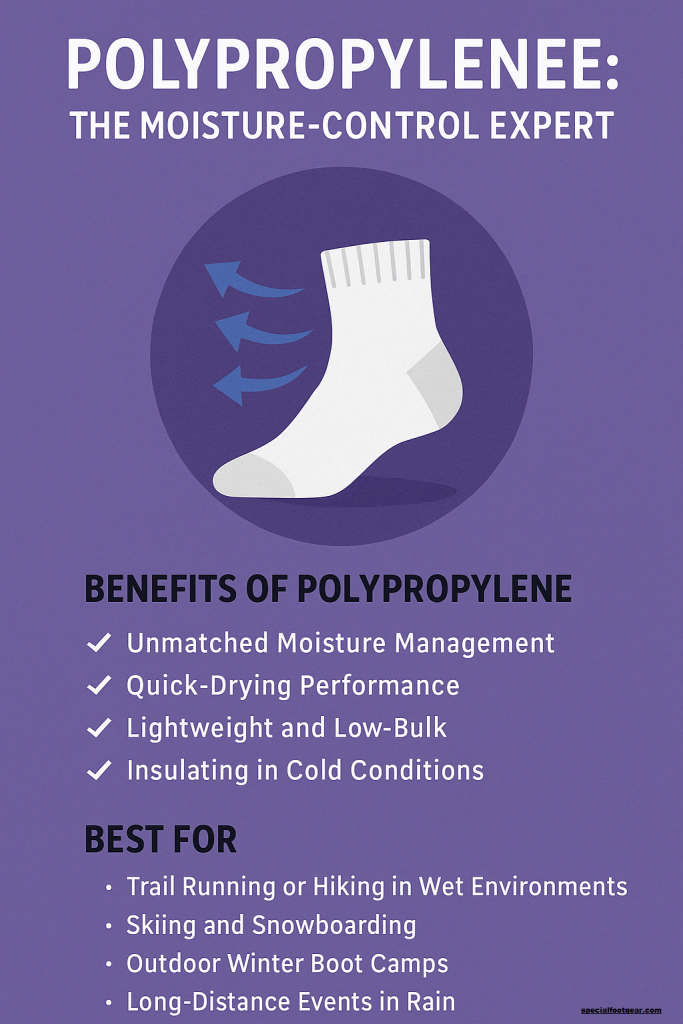
Best Use Cases for Polypropylene Sports Socks
Polypropylene may not be a household name like cotton or polyester, but it performs brilliantly in tough athletic scenarios:
- Trail running or hiking in wet environments
- Skiing and snowboarding
- Outdoor winter boot camps
- Long-distance endurance events in rainy or humid conditions
If staying dry is your top priority, socks with a polypropylene base layer are one of the most efficient solutions you can buy.
5. CoolMax: The Ultimate Performance Fabric
When it comes to combining comfort, breathability, and sweat control in one package, CoolMax stands out. Designed specifically for athletic use, this proprietary polyester fiber is engineered to keep feet cool, dry, and comfortable during intense physical activities. That’s why it’s often listed among the best materials for sports socks on product labels and athlete reviews alike.
What Is CoolMax?
CoolMax is not your average polyester. Developed by DuPont (now Invista), this fabric features specially shaped fibers that increase surface area and airflow, making it highly effective at managing moisture. It’s a go-to material for socks used in high-performance, high-sweat environments like running, cycling, and endurance training.
Key Benefits of CoolMax Socks
- Advanced Moisture Wicking
CoolMax quickly moves sweat from your skin to the outer layer of the sock, allowing it to evaporate faster than traditional materials. This keeps your feet dry and reduces the risk of blisters and odor. - Lightweight and Breathable
CoolMax socks are incredibly lightweight, making them feel almost invisible while still offering protection. The fabric encourages airflow, keeping your feet from overheating. - Soft, Smooth Comfort
Despite being synthetic, CoolMax is soft to the touch and glides comfortably against the skin. It’s a great alternative for people who dislike the feel of wool but still need performance-grade socks. - Machine-Wash Friendly and Durable
These socks hold up well in the wash, retain their shape, and continue to perform after repeated wear—making them a reliable choice for regular training.
Best Sports for CoolMax Socks
CoolMax socks are especially useful for high-intensity sports that involve constant motion and excessive sweat:
- Marathon and sprint running
- Indoor cycling and spinning
- CrossFit and boot camp training
- Triathlons and Ironman events
- Summer hiking and trail running
If your sport pushes you to your limits, CoolMax socks help your feet keep up.
6. Spandex (Lycra/Elastane): Stretch and Support
While it’s rarely the primary material in sports socks, Spandex—also marketed as Lycra or Elastane—is an essential ingredient in nearly all high-performance athletic socks. It provides the stretch and shape retention that makes socks supportive, form-fitting, and effective for movement.
When it comes to enhancing the best materials for sports socks, Spandex works behind the scenes to ensure everything fits like a second skin.
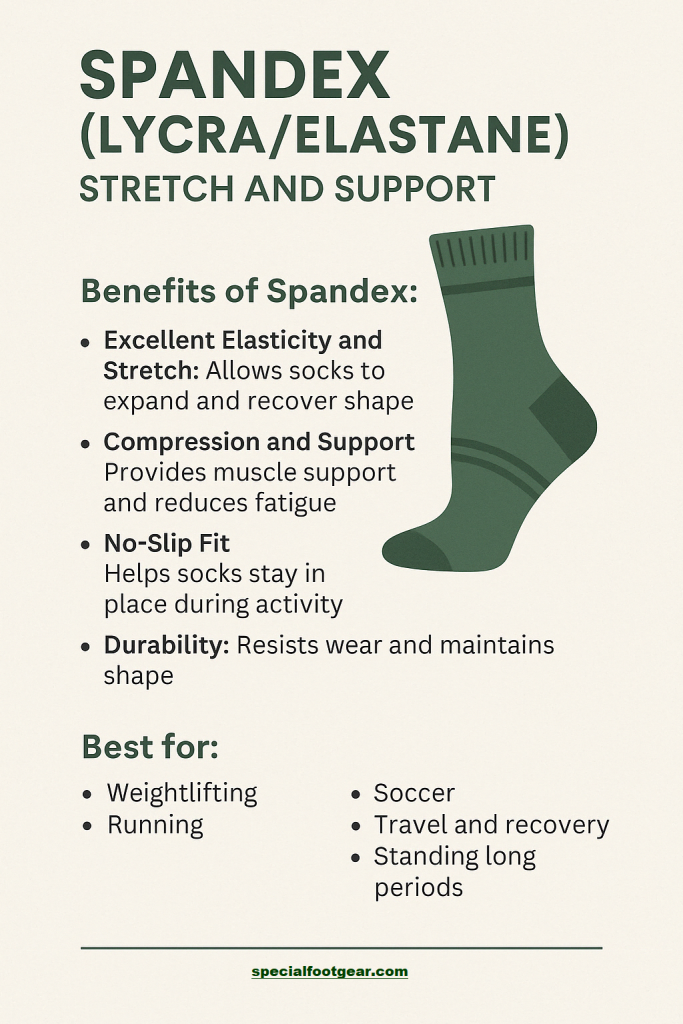
What Spandex Does in Sports Socks
- Excellent Elasticity and Stretch
Spandex can stretch up to 500% without breaking and instantly returns to its original shape. This makes it ideal for socks that need to stay snug and stable during motion. - Compression and Support
Many compression socks contain higher amounts of Spandex to apply gentle, graduated pressure to the feet and calves. This improves blood circulation, reduces fatigue, and helps manage swelling—especially during long runs, flights, or recovery periods. - No-Slip Fit
Spandex helps socks grip the foot and ankle without cutting off circulation. It prevents sagging, bunching, or slipping into your shoes, which can cause friction and blisters. - Durability and Shape Retention
With its resistance to wear and tear, Spandex helps socks maintain their structure—even after dozens of wears and washes.
Best Sports for Spandex-Enhanced Socks
Socks with Spandex are especially beneficial in activities where muscle fatigue, swelling, or foot slippage are concerns:
- Weightlifting and strength training
- Running and sprinting
- Soccer and high-movement sports
- Travel, flying, or recovery from long runs
- Standing for long periods (retail, nursing, hospitality work)
Conclusion: Choosing the Best Material for Your Sports Socks
The ideal material for your sports socks depends on the activity you engage in and the specific benefits you need from your socks. Whether you’re running, cycling, hiking, or participating in high-intensity training, each material offers unique advantages.
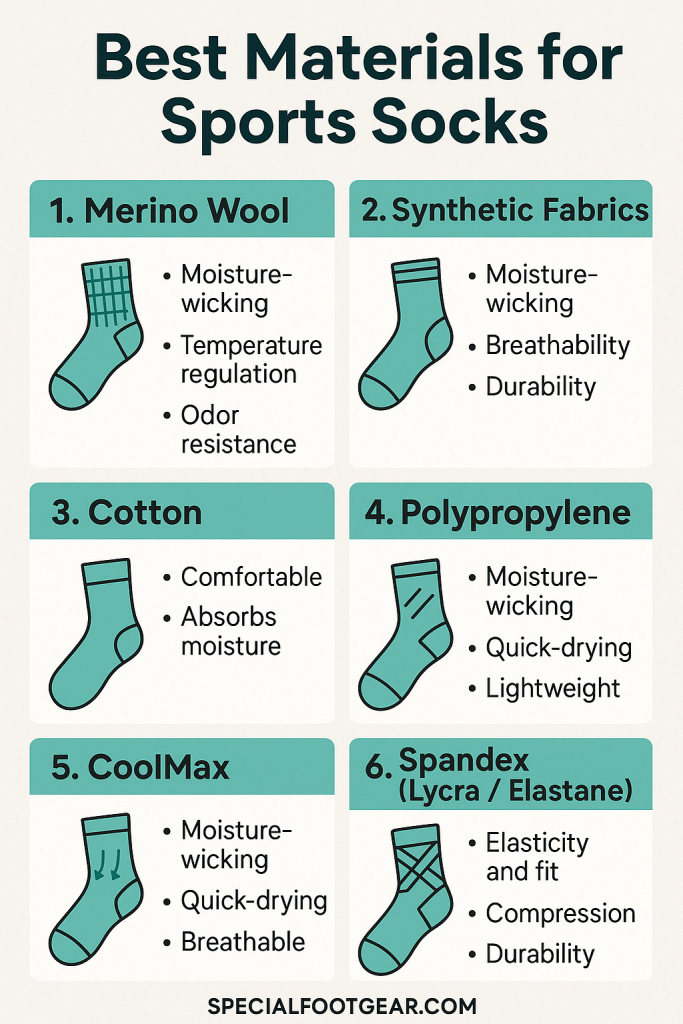
- Merino wool excels in versatility, moisture-wicking, and comfort, making it a great all-around option.
- Synthetic fabrics (nylon, polyester, acrylic) provide durability, breathability, and quick-drying properties, ideal for intense and high-sweat activities.
- Polypropylene is perfect for moisture management, particularly in cold or damp environments.
- CoolMax is engineered for moisture-wicking and comfort in high-performance sports.
- Spandex offers stretch and compression, supporting athletes who need additional support and muscle recovery.
When selecting the best socks for sports, make sure to consider factors such as moisture management, breathability, durability, and fit. Properly chosen socks will enhance comfort, improve athletic performance, and help you avoid injuries like blisters or foot fatigue. Investing in high-quality sports socks made from the right materials is a small but essential step toward maximizing your athletic potential.
Final Tip: Check the Label
When shopping, always check the label to see the fabric breakdown. Many high-performance socks blend two or more materials to provide the perfect mix of breathability, moisture control, support, and comfort. Brands like Darn Tough, Smartwool, and Balega offer excellent examples of these well-balanced socks.
Recent Posts
Neuropathy socks have open toes to enhance breathability and comfort for individuals with sensitive feet. This design allows for better airflow, reducing moisture and irritation. Neuropathy can...
Soothing Solutions: How To Warm Up Cold Feet From Neuropathy?
To warm up cold feet from neuropathy, try soaking them in warm water or using heated socks. Gentle foot massages also help improve circulation. Cold feet can be a common issue for individuals with...
